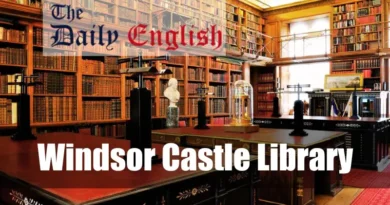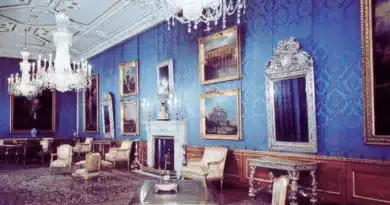Adelaide Cottage Interiors: Unveiling the Mysteries
Key Takeaways
| Key Takeaway | Details |
|---|---|
| Historical Context and Architecture | |
| Adelaide Cottage | A Grade II listed property built in 1831 by King William IV as a retreat for Queen Adelaide. |
| Architect | Designed by Jeffry Wyatville in the Gothic Revival style, featuring Bath stone, pointed arches, castellations, and decorative bargeboards. |
| Historical Significance | Site of Princess Victoria’s accession proclamation (1837) and home to notable royal figures, including the Duke and Duchess of Cambridge. |
| Architectural Style | |
| Gothic Revival Design | Evokes regality with a romantic, picturesque aesthetic. Features crenellated towers, pointed window frames, and decorative gardens originally curated by Queen Adelaide. |
| Insights into the Interiors | |
| Living Room Design | |
| Design Style | Reflects comfort and elegance with a cream sofa and cushions in pink, red, and white tones. |
| Personal Touches | Framed family photographs emphasise warmth and a focus on family. |
| Traditional and Modern Blend | Combines classic furniture with modern, welcoming elements for a regal yet homely feel. |
| Additional Glimpses | |
| Traditional Aesthetic | Extended into other areas with wooden cabinetry and framed artwork, as seen in the family’s Christmas card. |
| Design Themes | |
| Balancing Heritage and Modernity | The interiors respect the historic character of the cottage while incorporating modern updates for practicality and family life. |
| Colour Palette | Warm, neutral tones like cream dominate, with vibrant accents (e.g., pink and red) in soft furnishings adding warmth and personality. |
| Furniture and Textures | Features classic, comfortable pieces (e.g., a cream sofa) paired with textured fabrics like linen, plush throws, and natural fibres for a refined and functional look. |
I. Introduction to Adelaide Cottage Interiors
A. Historical Context of Adelaide Cottage
Nestled amidst the sprawling greens of Windsor Great Park lies Adelaide Cottage, a charming Grade II listed residence with a rich history dating back to the 19th century. Commissioned by King William IV in 1831 as a private retreat for his wife, Queen Adelaide, the cottage served as a haven for various royal residents over the years, including Queen Victoria’s mother, Princess Victoria of Saxe-Coburg-Saalfeld, and Prince and Princess Christian of Schleswig-Holstein. Today, Adelaide Cottage has found renewed significance as the official residence of the Duke and Duchess of Cambridge, Prince William and Catherine, and their three children – Prince George, Princess Charlotte, and Prince Louis.
1. Construction and Early Residents
Designed by renowned architect Jeffry Wyatville in the picturesque Gothic Revival style, Adelaide Cottage embodies the romantic spirit of the era. Wyatville, known for his work on Windsor Castle, crafted the cottage with local materials, including Bath stone with intricate castellated details. The initial design included four bedrooms, a drawing room, a dining room, and a library, providing a comfortable and elegant space for the royal couple.
Queen Adelaide, known for her gardening passion, actively shaped the surrounding landscape. Under her guidance, the cottage grounds transformed into a flourishing haven featuring picturesque gardens, a rose garden, and a fernery, further enhancing the tranquil charm of the residence.
2. Architectural Style and Significance
The architectural style of Adelaide Cottage reflects the prevalent trends of the early 19th century. The Gothic Revival style, characterized by pointed arches, castellations, and asymmetrical layouts, was popular for royal residences, evoking a sense of history and grandeur. Adelaide Cottage, with its crenellated towers, pointed window frames, and decorative bargeboards, embodies this style while maintaining a sense of intimacy and scale.
Beyond its architectural merit, Adelaide Cottage holds historical significance within the British Royal Family. It served as a testament to the growing influence of Queen Adelaide, who played a pivotal role in shaping the early reign of King William IV. The cottage also witnessed several historical events, including the signing of Princess Victoria’s accession proclamation in 1837, marking the beginning of her long and illustrious reign.
B. A Glimpse Inside: Unveiling the Interiors through Public Appearances
Due to the private nature of the residence, detailed information about the interiors of Adelaide Cottage remains limited. However, glimpses offered through public appearances by the Duke and Duchess of Cambridge have provided valuable insights into the design aesthetic and personal touches incorporated into the space.
1. The Living Room: A Welcoming and Personal Space
In a video message recorded for Addiction Awareness Week 2023, the Duchess offered a glimpse into the cottage’s living room. The space showcases a comfortable and inviting atmosphere, featuring a cream-coloured sofa adorned with a mix of pink, white, and red cushions. Framed photographs line the walls, adding a personal touch and suggesting a focus on family memories.
Expert analysis suggests a blend of traditional and modern elements in the living room. The clean-lined sofa’s classic design exudes a sense of regality while incorporating colourful cushions and personalized touches, adding warmth and reflecting the family’s character.
2. Additional Glimpses: Hints of Style in Other Rooms
Other public appearances have offered fleeting glimpses into additional areas of the cottage. In a 2022 Christmas card photograph, the Duke and Duchess are seen with their children in a room featuring a traditional wooden cabinet and framed artwork, suggesting a continuation of the classic aesthetic throughout the home.
It is important to note that these glimpses remain limited, and a comprehensive picture of the interior design remains available to the public.
II. Design Elements and Aesthetic

While full details remain under wraps, the available glimpses and public knowledge paint a picture of the design elements and aesthetics guiding the interiors of Adelaide Cottage.
A. Balancing Tradition and Modernity: The Overall Approach
The Duke and Duchess of Cambridge have curated the interiors to reflect a respect for the cottage’s historical significance. This likely translates to a tasteful blend of traditional and modern elements, creating a comfortable and functional space for their young family.
1. Respecting the Cottage’s Heritage
The historic character of Adelaide Cottage serves as a guiding principle for the design. The choice of traditional furniture pieces, the preservation of original architectural features, and the use of classic design elements demonstrate respect for the property’s heritage.
This approach ensures that any modern updates or additions complement the existing architecture and historical significance, preventing the space from feeling like a stark contrast to its past.
2. Incorporating Modern Touches for Comfort and Functionality
Despite the respect for tradition, the interiors of Adelaide Cottage are more than just a museum of historical relics. The Duke and Duchess have seamlessly integrated modern elements to ensure the space caters to their modern lifestyle and the needs of a young family.
Balancing tradition and modernity reflects the couple’s approach to their royal roles, combining their respect for history and heritage with the need for a comfortable and functional living space for their growing family.
B. Color Palette and Patterns: Creating a Warm and Inviting Atmosphere
While specifics about the colour palette throughout Adelaide Cottage remain under wraps, glimpses from public appearances offer clues about the overall aesthetic.
- Warm and Inviting Atmosphere: The limited view of the living room in a video message suggests a focus on creating a warm and inviting space. A cream-coloured base provides a neutral foundation, likely complemented by colourful accents for a touch of personality.
- The Power of Accents: The pops of colour seen in the cushions on the living room sofa hint at the potential use of accents and accessories to add vibrancy and reflect the Duke and Duchess’s preferences.
C. Furniture and Furnishings: A Blend of Comfort and Refinement
The limited glimpses of the Duchess’s cottage hint at a carefully chosen selection of furniture that likely combines comfort and refinement.
1. Selection of Furniture Pieces and Styles
If part of the Duchess’s taste, the cream-coloured sofa in the living room exemplifies a classic design with clean lines. This choice could suggest an appreciation for timeless pieces that provide both style and comfort.
Additional furniture choices in the cottage are unknown but could incorporate classic elements with modern functionality. For example, traditional armchairs might be reupholstered with contemporary fabrics, or vintage pieces could be paired with modern coffee tables. This reflects a common approach in interior design.
2. Fabrics and Textures: Adding Comfort and Detail
The fabrics and textures used in the furnishings likely play a crucial role in creating a cohesive and comfortable atmosphere. The use of soft fabrics on the sofa in the living room, if a true reflection of the Duchess’s taste, suggests an emphasis on comfort.
Additional fabrics throughout the cottage could include textured rugs, natural fibres like linen or cotton for curtains, and plush throws for added warmth. This combination of comfort and visual interest through textures would likely contribute to the interiors’ overall inviting and personal feel, but this remains speculation without further details.

FAQ
What are the main architectural features of Adelaide Cottage?
Adelaide Cottage showcases Gothic Revival architecture with pointed arches, castellations, and asymmetrical layouts. It includes distinctive features like crenellated towers and pointed window frames that reflect its historical significance.
Who designed Adelaide Cottage?
The cottage was designed by renowned architect Jeffry Wyatville, who was also involved in restoring Windsor Castle.
What is the significance of Adelaide Cottage in royal history?
Adelaide Cottage served as a private retreat for Queen Adelaide and later hosted several royal figures. It was also the site of significant historical events, including Princess Victoria’s accession proclamation in 1837.
What modern amenities are integrated into the interiors of Adelaide Cottage?
While the full details are not publicly disclosed, the Duke and Duchess of Cambridge are known to have integrated modern elements that cater to their family’s comfort, such as contemporary furniture and functional design features.
Has the original furniture been preserved in the cottage?
The original furniture is not fully documented, but there are indications that traditional and vintage pieces have been retained and restored while modern elements have been added to maintain comfort.
How does the design of Adelaide Cottage balance tradition and modernity?
The interiors maintain a focus on traditional elements to preserve the historical charm of the property while incorporating modern design elements to ensure comfort and functionality for the family.
Can the public visit Adelaide Cottage?
No, Adelaide Cottage remains a private residence for the Duke and Duchess of Cambridge and their family, with no public access currently available.
What materials were used in the construction of Adelaide Cottage?
The cottage was primarily constructed with local materials such as Bath stone, which contributes to its enduring charm and connection to the surrounding landscape of Windsor Great Park.
What role did Queen Adelaide play in the design of the cottage’s grounds?
Queen Adelaide, known for her passion for gardening, was instrumental in shaping the surrounding grounds, which included the creation of a rose garden, fernery, and other lush, picturesque landscapes.
Why is there limited information about the interior decor?
The private nature of the residence means that only glimpses of the interiors are shared during public appearances, ensuring the family’s privacy and protecting the space from public scrutiny.









